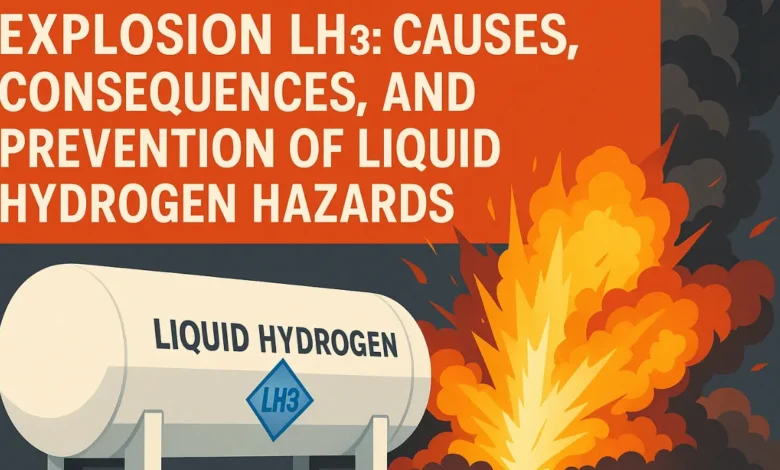Explosion LH3: Causes, Consequences, and Prevention of Liquid Hydrogen Hazards

In the age of advancing technologies and space exploration, liquid hydrogen (LH3 or LH2, as often interchangeably referred to) plays a crucial role as a clean and efficient fuel source. However, this powerful cryogenic fuel comes with serious risks. One of the most critical hazards is the potential for an Explosion LH3 scenario, which can have devastating consequences. This article investigates the causes, consequences, and prevention measures of LH3 explosions, offering technical insight and practical safety recommendations.
What is LH3 (Liquid Hydrogen)?
Liquid hydrogen is the fluid state of the element hydrogen, achieved by cooling it to a temperature below -252.87°C. Due to its low molecular weight and high energy content per mass, LH3 is widely used in rocket propulsion, hydrogen-powered vehicles, and energy storage systems. Its volatility, however, demands careful handling and robust safety systems.
Why is Explosion LH3 a Serious Concern?
Explosion LH3 refers to the ignition or detonation of hydrogen in its liquid or gaseous state due to various failure points. Hydrogen is highly flammable, and even a minor leak can result in a powerful explosion when mixed with air and exposed to a spark or heat source.
Causes of Explosion LH3
Several factors can lead to an LH3 explosion:
- Cryogenic Instability: When LH3 is exposed to higher temperatures, it rapidly vaporizes into gaseous hydrogen. This leads to a rapid expansion in volume and pressure, increasing the risk of explosion if containment fails.
- Leaks and Exposure to Air: Hydrogen’s tiny molecular size makes it prone to leaks. When leaked hydrogen mixes with air, it creates a highly combustible mixture that can be ignited easily.
- Contamination with Oxygen: Even trace amounts of oxygen can turn LH3 into an explosive mixture. Inadvertent contamination can have disastrous results in specific industrial settings.
- Mechanical Failures: Structural weaknesses or damage to valves, tanks, or pipelines can cause the uncontrolled release of LH3, leading to ignition under specific conditions.
- Electrostatic Discharge or Sparks: Due to its low ignition energy, hydrogen can be ignited by a slight static discharge or spark from nearby equipment.
Historical Explosions Involving LH3
Several incidents involving LH3 have been recorded, underscoring its hazardous nature:
- The Hindenburg Disaster (1937): Though it involved hydrogen gas, not LH3, the Hindenburg explosion serves as a historic reminder of hydrogen’s volatility.
- Apollo 13 Launchpad Incident: A leak in the LH3 fueling system created a dangerous situation during ground testing, highlighting the critical need for safety systems.
- Space Shuttle Challenger (1986): While the leading cause was O-ring failure, the presence of LH3 and LOX (liquid oxygen) contributed to the catastrophic explosion.
Consequences of Explosion LH3
The aftermath of an LH3 explosion can be wide-ranging:
- Infrastructure Damage: Facilities and equipment are often destroyed due to the high energy release.
- Human Casualties: Personnel in the vicinity of the explosion can suffer fatal injuries.
- Environmental Impact: Released hydrogen and explosion debris can lead to contamination and ecological disruption.
- Financial Loss: The cost of damages, investigations, and recovery can run into millions.
- Reputational Damage: Companies involved in such incidents often face public scrutiny and loss of trust.
Prevention and Safety Measures
Preventing an explosion LH3 scenario involves a combination of advanced engineering, rigorous protocols, and continuous monitoring:
- Proper Storage Design: To minimize leakage and pressure build-up, use double-walled, vacuum-insulated tanks designed for cryogenic fluids.
- Leak Detection Systems: Implement sensors and real-time monitoring systems to detect even minor hydrogen leaks.
- Flame Arrestors and Pressure Relief Valves prevent internal pressure from reaching dangerous levels and protect against ignition sources.
- Grounding and Bonding Equipment: Reduces the risk of electrostatic discharge in areas where LH3 is handled.
- Regular Maintenance and Inspections: Ensures that equipment is in optimal condition and can identify wear or damage before it leads to failure.
- Training and Safety Drills: Personnel should be trained in emergency procedures and conduct regular safety drills.
Scientific Research on Explosion LH3
Recent research has focused on the behavior of hydrogen under extreme conditions. Computational simulations and real-world experiments have shown that LH3 can transition from deflagration (burning) to detonation under specific scenarios, mainly confined in enclosures. Studies also explore materials compatibility, focusing on how certain metals become brittle at cryogenic temperatures, increasing the risk of failure.
Industry Applications and the Need for Vigilance
As hydrogen is increasingly adopted as a clean energy source, its use in fuel cell vehicles, aerospace, and grid energy storage demands strict adherence to safety protocols. Companies developing hydrogen infrastructure must integrate explosion LH3 risk assessments into every design, operation, and maintenance phase.
Conclusion
Explosion LH3 is a real and present danger in any industry handling liquid hydrogen. While LH3 holds promise as a green energy solution, its volatility requires rigorous controls and constant vigilance. Understanding the root causes, studying past incidents, implementing robust safety systems, and investing in research is critical to preventing disasters. With the proper precautions, the benefits of hydrogen energy can be realized without compromising safety.
FAQS
What makes liquid hydrogen (LH3) more dangerous than other fuels?
Liquid hydrogen is exceptionally volatile due to its extremely low boiling point (-252.87°C) and its tendency to vaporize rapidly upon contact with warmer environments. Its low ignition energy means a tiny spark or static discharge can ignite it. Also, hydrogen leaks are hard to detect because they are colorless and odorless, and their molecules are small enough to escape through microscopic cracks. These factors combined make LH3 more hazardous than many conventional fuels.
Can LH3 explosions occur without an open flame or visible heat source?
Yes. LH3 explosions can occur without an open flame. Hydrogen has one of the lowest ignition energies of any fuel, meaning it can ignite from a minor static electric discharge or friction-generated spark. Even without a visible heat source, leaked gaseous hydrogen mixed with air can combust violently under the right conditions.
How do leak detection systems help prevent LH3 explosions?
Leak detection systems use sensors to monitor the presence of hydrogen gas in real time. These sensors can trigger alarms or automated shutdown procedures at the first sign of a leak, allowing personnel to respond quickly and isolate the hazard. Early detection is crucial because even a tiny leak can lead to an explosive hydrogen-air mixture if not promptly addressed.
Are there specific materials that should be avoided when storing or transporting LH3?
Yes. Certain materials, especially some metals, become brittle at cryogenic temperatures and may crack or fail under stress when exposed to LH3. Materials used in LH3 systems must be tested for cryogenic compatibility and hydrogen embrittlement resistance. Specialized stainless steels and aluminum alloys are typically used, while materials like carbon steel are avoided unless specifically treated.
What industries are most at risk from Explosion LH3 incidents, and how are they responding?
Industries such as aerospace, fuel cell transportation, and hydrogen energy storage are most at risk due to their use of large volumes of LH3. These sectors are responding by investing in advanced safety systems, adopting international standards for cryogenic fuel handling, conducting regular staff training, and engaging in ongoing research to improve materials and designs. As hydrogen technology grows, so does the industry-wide emphasis on rigorous safety and risk management.




